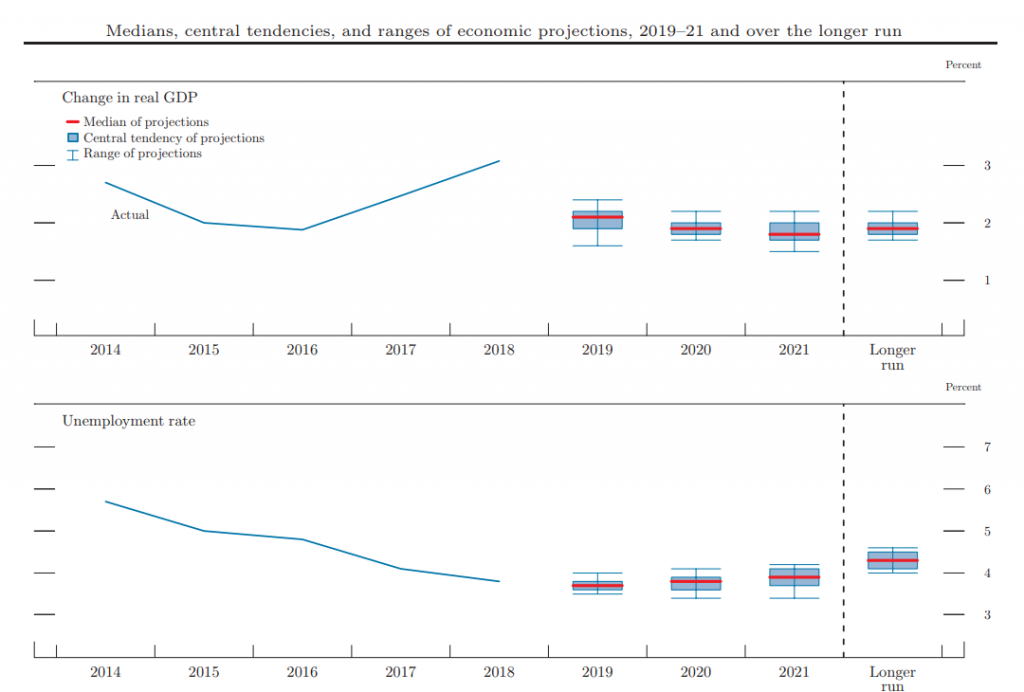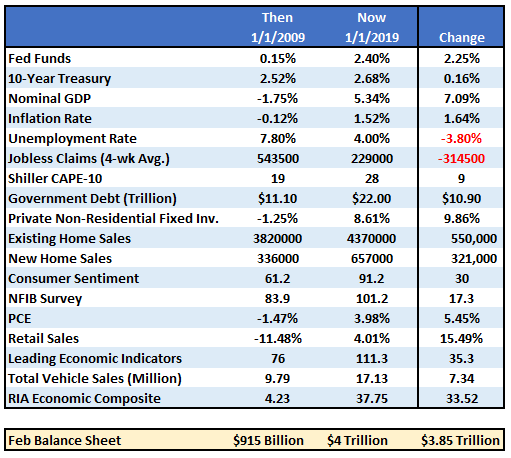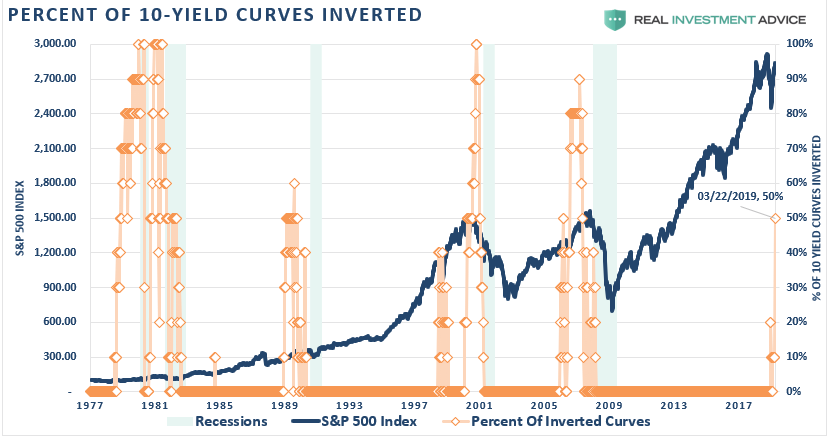Last week, the Federal Reserve released their March FOMC meeting minutes. Following the release, the markets surged higher as the initial reading by the markets was “the Fed is done hiking rates.” As the Wall Street Journal reported in Fed Minutes: Officials See Little Need to Change Rates This Year.
‘Minutes of the March meeting released Wednesday showed officials see little reason to continue raising rates due to greater risks to the U.S. economy from the global growth slowdown and muted inflation readings that took more officials by surprise.
‘A majority of participants expected that the evolution of the economic outlook and risks to the outlook would likely warrant leaving the target range unchanged for the remainder of the year,’ the minutes said.
At the same time, the minutes show officials didn’t perceive any need to cut their benchmark rate absent a broader deterioration in the economy. Officials said their view of the appropriate setting for interest rates ‘could shift in either direction based on incoming data and other developments.’
Since officials last met, President Trump has said he would like to see the Fed undo its last two rate increases. Fed officials have said they will base their decisions on the economic outlook and not political pressure.’
See, nothing to worry about as there are no recessions predicted by the Fed…ever.

As Peter Bookvar noted Wednesday afternoon, don’t believe for a moment the Fed isn’t specifically targeting the market:
“I’ve said many times to insert ‘S&P 500’ for ‘financial developments’ because that is essentially what we’re talking about here when its cited. So the Fed is referring to ‘significant uncertainties’ with regards to the S&P 500. What uncertainties exactly now since the S&P 500 is just off all time record highs?
They also acknowledged that their jawboning which shifted policy to one that is more ‘flexible’ is what boosted the stock market. ‘In their discussion of financial developments (S&P 500), participants observed that a good deal of the tightening over the latter part of last year in financial conditions (S&P 500) had since been reversed; Federal Reserve communications since the beginning of this year were seen as an important contributor to the recent improvements in financial conditions (S&P 500). Participants noted that asset valuations had recovered strongly.’
Thanks Fed, high five and the parenthesis and underline are obviously mine.”
But here is the problem with the market’s assumption:
“The Fed Did Not Say They Were Done Hiking Rates”
While the Fed said they would be “patient” for now, there are already indications that economic growth and inflation will pick up over the next couple of quarters, (No, this isn’t the revival of the economy, but simply a normal seasonal bounce from pent up demand following a cold winter.)
Complicating matters for the Fed is the strength of the dollar, the continued rise oil prices which is already leading to stronger inflationary prints, and increases in wages which will lead to concerns about an overheating economy. Such will put the Fed in a “box” with respect to both being “data dependent” as well as maintaining some semblance of “independence.”
In other words, while they may be “patient” for the moment, that doesn’t mean their position won’t change. As noted in their minutes:
“Most participants indicated that they did not expect the recent weakness in spending to persist beyond the first quarter.”
“Several participants noted that their views of the appropriate target range for the federal funds rate could shift in either direction based on incoming data and other developments. Some participants indicated that if the economy evolved as they currently expected, with economic growth above its longer-run trend rate, they would likely judge it appropriate to raise the target range for the federal funds rate modestly later this year”
Furthermore, as I noted in this past weekend’s missive, the Fed has already been dropping hints (since the March meeting) about further rates hikes in 2019 and 2020.
“Cleveland Fed President Loretta Mester:
‘Could we be done with policy rate increases this cycle? It is possible, but if the economy performs along the lines I think is the most likely case…the fed-funds rate may need to move a bit higher than current levels.’
Philadelphia Fed President Patrick Harker:
‘I continue to be in ‘wait-and-see mode‘ with expectations of at most, one hike for 2019 and one for 2020.”
Those comments don’t align with a Fed eager to sit on the sidelines, reduce rates, or begin to inject further stimulus.
However, while markets rallied on the idea the Fed will stay pat, for now, this still doesn’t alleviate the problems we noted previously:
- Yes, the Fed isn’t hiking rates, but they aren’t reducing them either.
- Yes, the Fed isn’t reducing their balance sheet any more after September, but they aren’t increasing it either.
- While economic growth outside of China remains weak, the year-over-year credit expansion in China IS slowing.
- Employment growth is slowing and will continue to weaken
- There is no massive disaster currently to spur a surge in government spending and reconstruction.
- There isn’t another stimulus package like tax cuts to fuel a boost in corporate earnings
- With the deficit already pushing $1 Trillion, there will only be an incremental boost from additional deficit spending this year.
- Unfortunately, it is also just a function of time until a recession occurs.
Most importantly, even if the Federal Reserve does begin to reverse course and inject liquidity, the effectiveness of those actions will likely not have the same effect.
Why?
Because the economic backdrop is not what it was a decade ago. The table below compares a variety of financial and economic factors from January of 2009 to January 2019.
“The critical point here is that QE and rate reductions have the MOST effect when the economy, markets, and investors have been ‘blown out,’ deviations from the ‘norm’ are negatively extended, confidence is hugely negative.
In other words, there is nowhere to go but up.”
Unfortunately, the Fed is trapped between the data and their “need to do something” to keep the asset prices inflated to support economic growth.
But that may not be enough as the bond market is already sniffing out the problems. Back to Peter Bookvar:
“The stock market is assuming…things will improve in Q2 and throughout the second half. The bond market has a less-optimistic take on that, saying that the data is weak, and we’re going to reflect that right now in lower yields and inversions within the yield curve.”
Currently, 5 out of 10 yield curves we track (50%) are now inverted. Such is the highest risk of a recessionary onset as we have seen since 2007.
For Boockvar’s part, the fixed-income market is the indicator to watch.
“The bond market is going to be right. We’re in a slowdown that’s not just temporary, and I think that’s something that’s going to last throughout the year.”
He is right.
While we are maintaining our equity exposure currently, we have also hedged those long-positions with gold and gold mining stocks, a heavier weighting than normal in cash, and have recalibrated the duration and credit risk in our bond holdings to account for the inversion.
This is simply because the “risks” continue to outweigh the reward for the markets currently. As Doug Kass recently noted:
- “Negative or near zero interest rates represent conditions that understandably exist immediately following a deep recession, not 10-years after.
- Fewer Tools Left in the Policy Shed as the Fed ends the tightening cycle with the absolute and real Federal Funds rate several hundred basis points lower than any economic cycle in history.
- Debt Is a Governor to Growth and debt that is not self-funding is future consumption brought forward.
- Deficit and Demographic Threats combined with a Fed balance sheet, which is four times normal, and slowing population growth, diminish intermediate to longer-term economic and profit growth prospects. Such is not supportive of higher valuations or asset prices.
- No Country Is an Economic Island and the lack of coordination between the super economic powers in the world will likely exacerbate worldwide economic risks.
- The Misallocation of Resources Causes Bubbles and low interest rates which we have experienced for years have always – in every cycle – been a source of ‘mischief’ and a misallocation of resources. The only question is ‘when’ something breaks it will ripple through the financial markets like a tidal wave. (Think about the proliferation of ‘covenant-lite’ loans.)”
Summary
While the Fed has successfully “jawboned” the markets recently to keep asset prices stable and positive, there will come a point where “verbal liquidity” simply isn’t enough. The fact that economic cycles will eventually complete seems to be lost on the Fed. As Mike Shedlock noted:
The weakness of inflation pressures given a strong job market and accelerating output last year has puzzled Fed officials. At last month’s meeting, they discussed reasons that inflation might have been more muted, including the prospect that the estimated level of unemployment rate consistent with stable prices is lower than previously thought.
Instead of wondering why inflation is weak, they ought to consider the absurdity of their models.
Stocks are priced beyond perfection, housing prices are so high no one can afford them, and the entire inflation expectations model they use is ridiculous.”
He is right about the Fed’s models and their reliance on low interest rates. Charlie McElligott discussed the three most important points about low interest rates (h/t Zerohedge)
- Low interest rates are (ultimately) deflationary, sustaining zombie-firms in a “liquidity-trap,” which weigh on overall economic performance while also weakening investment.
- Low interest rates and QE are deflationary as you incentivize mal-investment and blow perpetual speculative-asset bubbles, which (ultimately) correct and drive deleveraging—thus the ‘balance sheet recession.’
- As there is still a lot of debt-related “scar tissue,” you can’t push credit on a string. This then leads to quick “muscle memory” returns to a defensive posture: “If there is no return on capital, capital should not be deployed.”
Here are the most important takeaways from all of this:
- Despite an expected uptick in economic growth in Q2, look for weaker economic growth through the end of this year and into 2020.
- Employment is set to weaken markedly over the next 12-24 months.
- Wage growth gains will also reverse as tightness in the labor force eases.
- Inflationary pressures will remain non-existent as debt, disruption, and demographic forces continue to suppress economic growth.
- Go back to #1.
This is the cycle we are likely locked into currently and will continue to play out over the next several quarters. The markets are misreading what the Fed is really saying and investors will ultimately pay the price.

